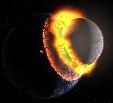|
Science and Astronomy Questions
|
|
| Alek | Date: Thursday, 03.11.2016, 14:29 | Message # 916 |
 Pioneer
Group: Users
 United States
United States
Messages: 326
Status: Offline
| Quote Watsisname (  ) It could be related to why we associate views from high places and mountain tops as being aesthetic.
Which just so happens to be where I take 95% of my SE screenshots 
EDIT: Okay, so, not sure where else to post this, so I will here. Is there currently any software out there right now that can test the stability of orbits over millions or billions of years in a reasonable amount of time (aka not having to dedicate 5 years of my life to wait for a simulation to run a few million years accurately)?
EDIT 2: Also, I've looked everywhere, but is there some sort of substance that could be a liquid with a lower viscosity than glass in a -19.84°F, 0.0247 Atm pressure environment? (It wouldn't have to have water-like viscosity, maybe more like lava? Just something that could move in a reasonable amount of time. Even if it evaporates after a few hundreds or thousands of years, if I can find a way to renew the supply, having it evaporate after awhile would be okay.)
Living among the stars, I find my way. I grow in strength through knowledge of the space I occupy, until I become the ruler of my own interstellar empire of sorts. Though The world was made for the day, I was made for the night, and thus, the universe itself is within my destiny.
Edited by Alek - Thursday, 03.11.2016, 18:19 |
| |
| |
| Watsisname | Date: Friday, 04.11.2016, 03:10 | Message # 917 |
 Galaxy Architect
Group: Global Moderators
 United States
United States
Messages: 2613
Status: Offline
| Quote Alek (  ) Is there currently any software out there right now that can test the stability of orbits over millions or billions of years in a reasonable amount of time (aka not having to dedicate 5 years of my life to wait for a simulation to run a few million years accurately)?
Indeed! There are packaged codes for n-body integrators using a variety of methods, and professional astronomers often use these to study the dynamics and stability of planetary systems. I don't have any experience in this area though, so I'm not sure how difficult it will be to learn how to use them.
https://www.boulder.swri.edu/~hal/swift.html
As for your second question... are we talking of substances which are common in nature, or can it be anything? I'm having a real hard time thinking of anything for this, but maybe Mercury works? This is the only reliable phase diagram I can find though, and it's definitely not clear as to what happens in the low-pressure regime. In these units you're looking at 0.000025 kbar and 244.4 K.

|
| |
| |
| Hornblower | Date: Friday, 04.11.2016, 14:46 | Message # 918 |
 World Builder
Group: Users
 United States
United States
Messages: 714
Status: Offline
| Ok, here's a tough one that I'm dying to know the answer to; What would it be like to have causation without correlation. At first glance it seems impossible, but there could be something.
|
| |
| |
| Alek | Date: Friday, 04.11.2016, 15:49 | Message # 919 |
 Pioneer
Group: Users
 United States
United States
Messages: 326
Status: Offline
| Quote Watsisname (  ) Indeed! There are packaged codes for n-body integrators using a variety of methods, and professional astronomers often use these to study the dynamics and stability of planetary systems. I don't have any experience in this area though, so I'm not sure how difficult it will be to learn how to use them. https://www.boulder.swri.edu/~hal/swift.html
Considering that I have practically no knowledge of programs like that (ones where "parameters" are entered into some type of text file and then the whole thing still needs to be complied) that would be quite difficult, but I guess thats to be expected, since basically everyone using that niche of a program is probably a researcher, which of course would know these things.
Quote Watsisname (  ) As for your second question... are we talking of substances which are common in nature, or can it be anything? I'm having a real hard time thinking of anything for this, but maybe Mercury works? This is the only reliable phase diagram I can find though, and it's definitely not clear as to what happens in the low-pressure regime. In these units you're looking at 0.000025 kbar and 244.4 K.
In this case, as long as it's not too complex of a substance (i.e. the only way it could possibly be made would be through mankind) pretty much anything would work, though the more common the material the better. Mercury seems to work according to that, but I agree, it is sort of unclear, and only barely works..
Too bad Thermo-calc is a hassle to get and seems to be more for metallurgy researchers and the academic version is limited as such that I probably wouldn't be able to find what I'm looking for...
Living among the stars, I find my way. I grow in strength through knowledge of the space I occupy, until I become the ruler of my own interstellar empire of sorts. Though The world was made for the day, I was made for the night, and thus, the universe itself is within my destiny.
Edited by Alek - Friday, 04.11.2016, 15:53 |
| |
| |
| Banana | Date: Friday, 04.11.2016, 23:45 | Message # 920 |
 Astronaut
Group: Users
 United States
United States
Messages: 56
Status: Offline
| Hornblower, suppose variable X causes the value of variable Y. Both these variables are affected by variable A, which has a equal chance of taking the value of either 1 or -1. Y is related to X in that Y=AX. There is no correlation among X and Y, though it is clear there is causation. I got this example from this website, which delves deeper into this subject.
Hello.
|
| |
| |
| Watsisname | Date: Saturday, 05.11.2016, 04:22 | Message # 921 |
 Galaxy Architect
Group: Global Moderators
 United States
United States
Messages: 2613
Status: Offline
| Quote Hornblower (  ) What would it be like to have causation without correlation.
This happens all the time in quantum mechanics. For example, you can set up a particle to have a spin oriented in one direction (let's say "up"). If you then measure the spin on that axis, you will measure a spin of +1. If you instead measure the spin with your apparatus flipped upside down, you'll measure a spin of -1.
But suppose you measure the spin along an axis 90° away from that (say, "left"). In that case, you'll have an equal probability of measuring a spin of +1 and a spin of -1. Furthermore, if this was a pair of entangled particles, then if you measure a +1 on your particle, someone else making the same measurement on the other particle will measure a spin of -1.
This is pretty weird. There is a correlation between the spins of the two entangled particles (measuring one determines the other), but the result you get on your particle has exactly zero correlation to how the spin of the particles was prepared, despite being causally related to it.
To have causation with no correlation is to have physics without predictive power. It means the state of a system at A directly leads to the state of the system at a later time B, but the rules for how A leads to B cannot be known.

|
| |
| |
| Hornblower | Date: Saturday, 05.11.2016, 11:29 | Message # 922 |
 World Builder
Group: Users
 United States
United States
Messages: 714
Status: Offline
| Banana, Watsisname, Thanks!
|
| |
| |
| spacer | Date: Saturday, 05.11.2016, 20:12 | Message # 923 |
 Star Engineer
Group: Users
 Israel
Israel
Messages: 1258
Status: Offline
| i had some physics question and i got that the acceleration of a bullet is 1200000meters per second square.
is that Makes sense?
in the answers in the book for the question it was correct eventually when you use newton second law with ma
the mass of the bullet was 0.0035kg
so 0.0035x1200000=4200newtons=4200N
but accelration of 1200000? wow 
maybe it make sense because the accelration is happening for very short time. less than a second... 
also i think i understood now why we float in space even if earth gravity is still working.
the spaceship is going down in earth gravity acceleration...so we float,
the spaceship may going down in earth gravity acceleration but the speed is so high its never really goes down to earth.
its like an elevator when its goes down you float and feel easier.
i understood it to be something close to that...is that correct? and if so can you give farther information? 
"we began as wanderers, and we are wanderers still"
-carl sagan
-space engine photographer
Edited by spacer - Saturday, 05.11.2016, 20:26 |
| |
| |
| Watsisname | Date: Sunday, 06.11.2016, 01:13 | Message # 924 |
 Galaxy Architect
Group: Global Moderators
 United States
United States
Messages: 2613
Status: Offline
| Quote spacer (  ) i had some physics question and i got that the acceleration of a bullet is 1200000meters per second square.
Depends on the gun, but your result seems reasonable. Let's figure out a way to calculate the acceleration of a projectile (as it is fired) in general and see if we come up with a sensible answer that agrees with that.
In general we probably do not know the time it takes for the bullet to be accelerated. It is very fast and hard to measure. But we can usually know the muzzle velocity, and the length of the barrel. So we can use one of the basic kinematic equations to find the acceleration:

We know the initial velocity (v0 )of the bullet is 0, and it accelerates to vf which is the muzzle velocity. It does this over the length of the barrel, which is (s-s0). Let's redefine s-s0 as "L", and solve for a. We get

So the acceleration is the square of the muzzle velocity, divided by twice the barrel length. To get a ballpark figure, consider a muzzle velocity of 1000m/s and a barrel length of half a meter. Then the acceleration is exactly 106 m/s2. Makes sense!
Quote spacer (  ) maybe it make sense because the accelration is happening for very short time. less than a second...
Precisely. Big change in velocity over a very short interval of time. In fact, let's calculate that as well, using the above example of 1000m/s over 0.5 meters. How long did it take?
This time we'll use the kinematic equation

Solve for t, it is just v/a. 1000m/s divided by 106 m/s2 is 0.001s, or 1 millisecond. Pretty quick.
Quote spacer (  ) i understood it to be something close to that...is that correct? and if so can you give farther information?
Yeah, you pretty much have it.  Not only is the spaceship being pulled down by gravity, but so is everything on it. And one of the funky things about gravity is that all objects in a gravitational field fall with the same acceleration, no matter what their mass is. Not only is the spaceship being pulled down by gravity, but so is everything on it. And one of the funky things about gravity is that all objects in a gravitational field fall with the same acceleration, no matter what their mass is.
It's not obvious to us on Earth that gravity works that way, because air resistance adds an additional force which complicates it. But we can test it in vacuum chambers, or on the surface of the Moon:
So in space, the ship and everything on it are falling together, and to someone inside it seems like everything is weightless and freely floating. And remember, you don't feel gravity. What you feel are other forces which prevent you from being in freefall. This is just like the elevator example.
That the ship is falling down would definitely be a problem if it started out at rest somewhere above the Earth. It would fall down and into the atmosphere quite quickly, and then everyone on board would have a bad time. So the ship has to be moving sideways, really fast, so that it falls "around" the Earth. We can calculate the sideways speed that it needs to be able to circle the Earth, too. When you start learning about physics problems involving circular motion, this might be a fun thing to try to derive. 

|
| |
| |
| Alek | Date: Sunday, 06.11.2016, 07:58 | Message # 925 |
 Pioneer
Group: Users
 United States
United States
Messages: 326
Status: Offline
| How much gravity would they feel if the station was somehow "locked" to the same place, the same distance from the Earth (basically, it would be locked in place in an "absolute space" that moves with Earth, though it still feels the Earth's gravitational field, it doesn't fall due to it.) Would they feel 1g, or less because they're farther from the ground, or more because the planet's gravity isn't pulling on it from 180 degrees like it does on the surface, and therefore is more concentrated in a downward pull?)
Living among the stars, I find my way. I grow in strength through knowledge of the space I occupy, until I become the ruler of my own interstellar empire of sorts. Though The world was made for the day, I was made for the night, and thus, the universe itself is within my destiny.
|
| |
| |
| Watsisname | Date: Sunday, 06.11.2016, 09:50 | Message # 926 |
 Galaxy Architect
Group: Global Moderators
 United States
United States
Messages: 2613
Status: Offline
| The ISS is currently at an altitude of 406.5km above the Earth. At that altitude, the acceleration due to gravity is 8.68m/s2, or about 88% the strength of gravity on Earth's surface. If you weigh 80kg here on Earth's surface, then on a stationary platform at that altitude you would weigh 70kg. (Of course, your mass is still 80kg.)
So yes, gravity is still pretty strong up there.  That's because 400km altitude is not very much farther from the center of the Earth compared to being on the surface of the Earth. That's because 400km altitude is not very much farther from the center of the Earth compared to being on the surface of the Earth.
To calculate, equate Newton's Law F=ma with the force of gravity F=GMm/r2. Solve for a. The little m, being the mass of the object, cancels (which is why all objects have the same acceleration due to gravity regardless of their mass). We get:
a=GM/r2
where G is the gravitational constant, M is the mass of the object you're gravitating towards (assuming it is a sphere and you're not inside of it), and r is your distance from its center.

|
| |
| |
| apenpaap | Date: Monday, 07.11.2016, 15:15 | Message # 927 |
 World Builder
Group: Users
 Antarctica
Antarctica
Messages: 1063
Status: Offline
| How did people come to realise the gas giants are gas giants and don't have a solid surface? I remember reading a popular theory for the great red spot used to be that it was a massive mountain poking out of Jupiter's atmosphere, so clearly there was a point where we thought they were solid worlds.
I occasionally stream at http://www.twitch.tv/magistermystax. Sometimes SE, sometimes other games.
|
| |
| |
| Watsisname | Date: Tuesday, 08.11.2016, 01:40 | Message # 928 |
 Galaxy Architect
Group: Global Moderators
 United States
United States
Messages: 2613
Status: Offline
| I hadn't heard that theory -- that's pretty interesting.  I'm not sure of the history behind that, but I can propose one calculation which might have been part of what helped convince people that they are gas giants and cannot have solid surfaces. The calculation will be to determine the average density of the planet by observable quantities: the size of the planet, the distance of its moons, and the orbital period of the moons. Then the average density will tell us something about what the planet must be made out of. I'm not sure of the history behind that, but I can propose one calculation which might have been part of what helped convince people that they are gas giants and cannot have solid surfaces. The calculation will be to determine the average density of the planet by observable quantities: the size of the planet, the distance of its moons, and the orbital period of the moons. Then the average density will tell us something about what the planet must be made out of.
Start with Newton's Law of gravity. F=ma, and the force of gravity is F=GMm/r2 (Aye, these two equations strike again! But we'll take them somewhere new.) With the moons being on essentially circular orbits, we can also equate the gravitational force of the planet on its moons to be a centripetal force of mv2/r
where r is the distance of the moon from the planet and v is the moon's orbital speed.
Let's do some algebra!
Relating these expressions for the force, we can write

We can cancel out the mass of the moon "m" from them, so that's nice.
The orbital speed of a moon around a planet is a bit inconvenient as a remote measurement. It would be nice if we could instead relate it to the orbital period and the orbital distance, which are easier to measure. For a circular orbit, that is:

where T is the orbital period.
Plug that expression in for v2 in the previous relation, and we get

Let's rearrange that slightly:

Does it look familiar to anyone? This is actually Kepler's Third Law, relating the square of the orbital period to the cube of the orbital distance.
Okay, one last variable which we want to replace. That's M, the mass of the planet, which we can't really measure directly. But we can relate it to the radius of the planet "R", and the average density "ρ". The average density is what we actually want to find at the end of the day, so that's great. Density is mass per volume, so mass is volume times density. And the volume of a sphere is 4/3*pi*R3. So we'll substitute in for M:

Which gives us

And finally, solving for the planet's density:

That's pretty neat. We can find the average density of a planet, provided that it has moons.
Consider Jupiter's moon Io. It orbital distance is about 422,000km, and its orbital period is 42 hours, 27 minutes. The (average) radius of Jupiter is about 69,900km. Plug these in and convert accordingly, and we derive an average density of Jupiter of 1.33 g/cm3. This is exactly the accepted value. 
1.33 g/cm3 is very low for a rocky planet with a metal core. (Mercury, Venus, and Earth are all above 5, and Mars is 3.93) Even a purely rocky planet without a dense core should be at least 2 or 3. So Jupiter must be primarily made up of lighter materials. We might suppose water, but that doesn't really work too well on that scale. (And it doesn't work at all for Saturn -- it's average density is even less than water!). The only things that make sense are gaseous elements like hydrogen and helium. And if you have a planet made primarily of those, then it can't have a solid surface. Planets will differentiate with the denser stuff going to the center and the lighter stuff on top.
So we reach the conclusion that Jupiter and other "gas giants" must be made primarily of light elements, with thick gaseous atmospheres. Then, since the pressure goes up as you move in, there must be a smooth transition from gaseous to a fluid state, which we learn from studying physical chemistry and phase transitions.

|
| |
| |
| steeljaw354 | Date: Tuesday, 08.11.2016, 11:13 | Message # 929 |
 World Builder
Group: Users
 Pirate
Pirate
Messages: 862
Status: Offline
| What if Pluto was the only object out beyond Neptune? What if Ceres successfully cleared out it's orbit? And by Pluto being the only object out beyond Neptune, I mean if it had cleared out the entire Kuiper belt, somehow.
Edited by steeljaw354 - Tuesday, 08.11.2016, 11:19 |
| |
| |
| FastFourierTransform | Date: Tuesday, 08.11.2016, 12:38 | Message # 930 |
 Pioneer
Group: Local Moderators
 Spain
Spain
Messages: 542
Status: Offline
| Quote steeljaw354 (  ) What if Pluto was the only object out beyond Neptune?
The New Horizons team would face unemployement by now instead of been active for several years more and we would be very enthusiastic about the contradictions this magic would generate with our current models for the Solar System formation.
Quote steeljaw354 (  ) What if Ceres successfully cleared out it's orbit?
It would have automatically to be considered a planet by the IAU definition. Since the mass of the entire Main Asteroid Belt is about 4% that of our Moon or 22% that of Pluto you would have a very very small planet.
Quote steeljaw354 (  ) Pluto being the only object out beyond Neptune, I mean if it had cleared out the entire Kuiper belt, somehow.
It would have automatically to be considered a planet by the IAU definition, also. Since the mass of the entire Kuiper Belt is 0,1 Earth's masses you would have a Mars sized Pluto. Would this generate disturbances? I guess not to much since Pluto is quite isolated: the closest aproach to another object of the Solar System would be Uranus (surprisingly!!!) and it would get at max to 11AU from it. Consider that a Mars-sized planet currently aproaches Earth as close as 0,36AU and nothing happens with our Moon for example, no disturbances at all. Nothing would change in the rest of the Solar System.
|
| |
| |